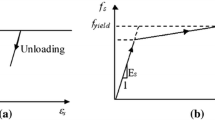Abstract
In this work, we present a new finite element for (geometrically linear) Timoshenko beam model for ultimate load computation of reinforced concrete frames. The proposed model combines the descriptions of the diffuse plastic failure in the beam-column followed by the creation of plastic hinges due to the failure or collapse of the concrete and of the re-bars. A modified multi-scale analysis is performed in order to identify the parameters for stress-resultant-based macro model, which is used to described the behavior of the Timoshenko beam element. For clarity, we focus upon the micro-scale models using the multi-fiber elements with embedded displacement discontinuities in mode I, which would typically be triggered by bending failure mode. More general case of micro-scale model capable of describing shear failure is described by Ibrahimbegovic et al. (Int J Numer Methods Eng 83(4):452–481, 2010).
Similar content being viewed by others
References
Anthoine A, Guedes J, Pegon P (1997) Non-linear behavior of reinforced concrete beams: from 3D continuum to 1D member modeling. Comput Struct 65(6): 949–963
Armero F, Ehrlich D (2006) Numerical modeling of softening hinges in thin Euler–Bernoulli Beams. Comput Struct 84: 641–656
Brancherie D, Ibrahimbegović A (2009) Novel anisotropic continuum–discrete damage model capable of representing localized failure of massive structures. part I: theoretical formulation and numerical implementation. Eng Comput 26(1–2): 100–127
Cipollina A, Lopez-Inojosa A, Florez-Lopez J (1995) A simplified damage mechanics approach to nonlinear analysis of frames. Comput Struct 54: 1113–1126
Cusatis G, Bazant Z, Cedolin L (2006) Confinement-shear lattice csl model for fracture propagation in concrete. Comput Methods Appl Mech Eng 195(52): 7154–7171
Dujc J, Brank B, Ibrahimbegovic A (2010) Multi-scale computational model for failure analysis of metal frames that includes softening and local buckling. Comput Meth Appl Mech Eng 199(21–22): 1371–1385
Ehrlich D, Armero F (2005) Finite element methods for the analysis of softening plastic hinges in beam and frames. Comput Mech 35: 237–264
Florez-Lopez J (1998) Frame Analysis and Continuum Damage Mechanics. Eur J Mech A Solids 17(2): 269–283
Gal E., Ganz A., Hadad L., Kryvoruk R. (2008) Development of a concrete unit cell. Int J Multiscale Comput Eng 6(5-6): 499–510
Gregori J., Sosa P., Fernández Prada M, Filippou F (2007) A 3d numerical model for reinforced and prestressed concrete elements subjected to combined axial, bending, shear and torsion loading. Eng Struct 29(12): 3404–3419
Ibrahimbegovic A (2009) Non linear solid mechanics. Springer, New York
Ibrahimbegovic A, Boulkertous A, Davenne L, Brancherie D (2010) Modelling of reinforced-concrete structures providing crack-spacing based on X-FEM, ED-FEM and novel operator split procedure. Int J Numer Methods Eng 83(4): 452–481
Ibrahimbegovic A, Brancherie D (2003) Combined hardening and softening constitutive model of plasticity: precursor to shear slip line failure. Comput Mech 31: 88–100
Ibrahimbegovic A, Frey F (1993) Stress resultants finite element analysis of reinforced concrete plates. Eng Comput 10(1): 15–30
Ibrahimbegovic A, Wilson E (1991) A modified method of incompatible modes. Commun Numer Methods Eng 7: 187–194
Jirasek M (1997) Analytical and umerical solutions for frames with softening hinges. J Eng Mech ASCE 123(1): 8–14
Kotronis P, Mazars J, Davenne L (2003) The equivalent reinforced concrete model for simulating the behavior of walls under dynamic shear loading. Eng Fract Mech 70(7–8): 1085–1097
Lubliner J (1990) Plasticity theory. Mac-Millan, London
Marante M, Picon R, Florez-Lopez J (2004) Analysis of localization in frame members with plastic hinges. Int J Solids Struct 41: 3961–3975
Marante M, Suárez L, Quero A, Redondo J, Vera B, Uzcategui M, Delgado S, León R, Núñez L, Flórez-López J (2005) Portal of damage: a web-based finite element program for the analysis of framed structure subjected to overloads. Adv Eng Softw 36: 346–358
Moulin S, Davenne L, Gatuingt F (2003) Réponse statique d’une poutre en béton armé (section rectangulaire) à à comportement non linénaire. In: Technical report. Code Aster, Cachan
Nanakorn P. (2000) A two-dimensional beam-column finite element with embedded rotational discontinuities. Comput Struct 82: 753–762
Oller S, Barbat A (2006) Moment curvature damage model for bridges subjected to seismic loads. Comput Methods Appl Mech Eng 195(33–36): 4490–4511
Pham B, Davenne L, Brancherie D, Ibrahimbegovic A (2010) Stress resultant model for ultimate load design of reinforced-concrete frames: combined axial force and bending moment. Comput Concr 7(4): 303–315
Rajasankar F, Nagesh R, Prasad A (2009) Modelling inelastic hinges using CDM for nonlinear analysis of reinforced concrete frame structures. Comput Concr 6(4): 319–341
Riva P, Cohn M (1990) Engineering approach to nonlinear analysis of concrete structures. J Struct Eng 116(8): 2162–2186
Spacone E, Filippou F, Taucer F (1996) Fiber beam-column model for nonlinear analysis of RC frames. Earthq Eng Struct Dyn 25(7): 711–742
Vecchio F, Emara M (1992) Shear deformations in reinforced concrete frames. ACI Struct J 89(1): 46–56
Zienkiewicz O, Taylor R (2000) The finite element method, 5th edn. Butterworth–Heinemann, Oxford
Zingales M, Elishako I (2000) Localization of the bending response in presence of axial load. J Solids Struct 37: 6739–6753
Author information
Authors and Affiliations
Corresponding author
Rights and permissions
About this article
Cite this article
Pham, B.H., Brancherie, D., Davenne, L. et al. Stress-resultant models for ultimate load design of reinforced concrete frames and multi-scale parameter estimates. Comput Mech 51, 347–360 (2013). https://doi.org/10.1007/s00466-012-0734-6
Received:
Accepted:
Published:
Issue Date:
DOI: https://doi.org/10.1007/s00466-012-0734-6




